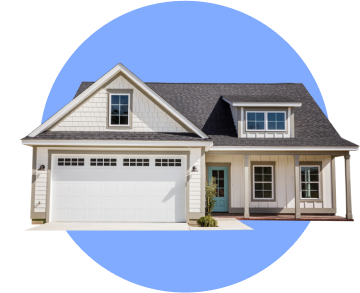Home insurance calculator: Estimate your costs
How to calculate home insurance
Every home insurance company uses a proprietary algorithm to estimate the cost of your home insurance — but you can still come up with a general estimate before you request personalized quotes by running the numbers on your home and finances. Calculating your home insurance costs involves estimating your rebuild costs, valuing your assets and personal property and reviewing the types of coverage and endorsements you may want to include in your policy.
1. Estimate costs to rebuild
Start by estimating your home's rebuild cost. This will determine the dwelling coverage limit on your policy — meaning the limit of what your insurance company will pay out to repair or rebuild your property following a covered loss. The appropriate dwelling coverage amount will in turn determine the coverage limits of other sections of your policy.
The simplest formula for estimating rebuild costs is your home's square footage multiplied by the average building cost per square foot in your area. However, a more precise estimate will also take into account:
- The age of your home
- Construction materials used in the home
- Quality of fixtures such as countertops, lighting and cabinets
- Design and style of the home
- Foundation type
- Finished or unfinished basement
2. Value your assets & personal property
In addition to covering the cost to rebuild your home, you must consider the value of your total assets — including any property you own, vehicles, retirement accounts and investments — along with your personal property. Your home insurance policy's liability and personal property sections will apply to these, and the total value of your assets and property may determine whether additional coverage is needed.
3. Determine how much coverage you need
Start by determining the coverage limits you'll need for the six types of standard coverage on your policy. These coverage limits are usually interdependent, so work closely with a licensed agent to settle on the right level of coverage.
Dwelling coverage
The foundation of your home insurance policy, this helps pay to repair or replace the main structure of your home and any attached structures, such as a porch. Your dwelling coverage should total at least 80 percent of your home's value, but it's best to cover the full replacement cost.
Other structures coverage
Sheds, driveways, fences and other structures not directly attached to your primary dwelling are covered under other structures coverage. The limit is usually 10 percent of the dwelling coverage amount.
Personal property coverage
Personal property coverage helps pay to repair or replace your personal belongings and may have a limit of 50 or 75 percent of the dwelling coverage limit.
Personal liability coverage
Your home insurance policy's personal liability section helps cover legal costs if you're found responsible for bodily injury or property damage to others. Most insurers offer between $100,000 and $500,000 of liability coverage on a standard policy.
Additional living expenses (ALE) coverage
Also known as “loss of use” coverage, ALE helps cover the cost of alternative living arrangements if your home is uninhabitable due to a covered loss, such as a house fire. It's usually set at 20 or 30 percent of your dwelling coverage limit.
Medical payments coverage
If someone is injured on your property, this coverage can help to pay for their medical expenses regardless of whether you're found at fault. A typical limit is $1,000 per person, but you may be able to purchase limits of up to $5,000.
4. Consider additional coverage types
The six standard coverages in your home insurance policy won't cover everything. To fill in gaps in your default coverage, you might look into adding some of the following additional coverage types. Keep in mind that not all insurance companies offer all of these endorsements, and you'll pay an extra premium for those you elect to add.
- Flood insurance: Standard home insurance won't cover flood damage, and most households in the U.S. need flood coverage — even if the home isn't located in a high-risk flood zone. Flood insurance is usually available as a separate policy, not an endorsement on your existing home insurance policy.
- Earthquake insurance: Another natural disaster not covered by home insurance, earthquakes can pose a serious threat to your home and finances. Earthquake insurance may be available as either a separate policy or an endorsement.
- Sewer backup insurance: A standard home insurance policy won't cover damage from a sewer backup, so consider adding sewer backup insurance to your coverage.
- Identity theft coverage: A common low-cost endorsement for home insurance policies is identity theft protection, which can help cover common costs associated with identity theft, such as legal fees.
- Windstorm insurance: If you live in an area prone to serious damage from windstorms, you may need to add an endorsement to your policy to protect against financial losses from this phenomenon.
What you'll need to estimate your home insurance
ZIP code
Insurers use your ZIP code to determine your town's natural disaster history and your home’s proximity to a fire or police station.
Credit
In all states except California and Maryland, an insurer can use your credit history when setting your rate. If you’re not sure what your credit score is, you may want to enter “Good” or “Fair” to get a rough estimate of your costs.
Dwelling coverage limit
This is roughly what it would cost to completely rebuild your home. This differs from the home's market value and does not include the value of the land your home is on. The dwelling limit is one of the most important parts of your policy, as the coverage you have for other structures on your property and for your personal belongings is set based on a percentage of your dwelling limit.
Construction year:
Check all paperwork from your home sale to find the year your home was originally constructed. You don’t need to know the exact year to use the calculator, but try to enter your closest approximation to get a more accurate estimate.
Deductible
This is the amount of damage you agree to cover out of pocket in the event of a claim. The insurer covers the rest, up to your policy limits. Higher deductibles like $5,000 usually result in lower premiums, while lower deductibles (think $1,000) yield higher premiums.
Claim history
If you’ve filed a home insurance claim before, or the property you own has a long claims history, you may face higher rates.
How much should I pay for homeowners insurance?
Methodology
Rates
Bankrate utilizes Quadrant Information Services to analyze November 2025 rates for all ZIP codes and carriers in all 50 states and Washington, D.C. Quoted rates for our base profile are based on the following characteristics and coverage limits:

Dwelling coverage
$300,000Other structures coverage
$30,000Personal property coverage
$150,000Loss of use coverage
$60,000Liability coverage
$500,000Medical payment coverage
$1,000The homeowners also have a $1,000 deductible, a $500 hail deductible and a 2 percent hurricane deductible (or the next closest deductible amounts that are available) where separate deductibles apply.
These are sample rates and should be used for comparative purposes only. Your quotes will differ.
If otherwise specified, the base profile has been modified with the following homeowner characteristics:
Dwelling coverage:
- Coverage A, Dwelling: $150,000, $350,000, $450,000, $750,000
- Coverage B, Other Structures: $15,000, $35,000, $45,000, $75,000
- Coverage C, Personal Property: $75,000, $175,000, $225,000, $375,000
- Coverage D, Loss of Use: $30,000, $70,000, $90,000, $150,000
- Coverage E, Liability: $500,000
- Coverage F, Medical Payments: $1,000
